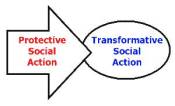
Having planted a church, I’ve become convinced of something. New churches in North America must move from a purely pastoral mindset into a missionary mindset. However, in the evangelical sub-culture, the leader of
any church, including a church
plant, is supposed to first be the people's “
pastor”... that is, the church-planter is
not supposed to be
first the leader of a band of missionaries to affect a culture for Christ, but rather the care-taker of the people in the church.
This is a tension for church planters.
On top of this tension, most denominations want to see rapid growth from their church plants, which usually means that the church-planting pastor has to make compromises to the mission-mindedness of the project so that the church can attract
Christians from other churches in order to grow quickly.
The tension is between the "pastoral context" of modern evangelicalism and the "missional context" needed to reach new people with the gospel.
True missionary work takes time and it takes sacrifice. A church planter must make mission the priority, even at the risk of not being as pastoral as most in the congregation would like.
I felt this tension. As I pastored a new church, attempting to reach a new group of people with the gospel of Christ, some of the key people in the core group of the church began to demand that I be their “pastor.” I was supposed to care for the needs of those in the church – providing programs for youth and providing teaching and worship expriences that would be pleasing to the standard evangelical ear.
The question underlying the church-planter’s calling is this: Do you care more about those “out there” than you do for those “in here?” If you appear to care more for those "out there," the evangelicals in your midst will soon resent you.
Now, here’s where the tension was found for me. I actually
wanted to be their pastor, and yet I was attempting to create an environment where we would all see ourselves as
missionaries. I wanted to be able to accomplish
both, and my negotiation of this tension left a lot to be desired. In the end, I’m afraid I did both tasks poorly.
It takes a special person to be the leader of missionaries as well as be the pastor of a church. Perhaps this is why church planting is a unique calling. Perhaps this is why you need more than one person at the point - a team of people to perform all the nuances of church-planting ministry. Perhaps this is why so many church plants fail – denominations do not see church plants in the same light as over-seas missions and are failing to think in innovative ways to make new ventures successful in reaching people. Funding is set up poorly, long-term viability is not pursued.
The church needs to think in missionary terms instead of pastoral terms to reach a postmodern American culture. And yet, the people in the church that is being established need to be pastored.
This is the tension of church planting. Any suggestions?
technorati: emerging church, spiritual formation
 Yesterday, I posted about how evangelicals have succumbed to a “protective social action” rather than following the Lord’s calling of a “transformative social action.”
Yesterday, I posted about how evangelicals have succumbed to a “protective social action” rather than following the Lord’s calling of a “transformative social action.”

 Reaching a new generation in a postmodern culture will take creative thinking outside the standard church box. This is what Rob and Debbie Toews, Steve and Anika Martin, and Dave Wakulchyk have done by starting an internet coffee shop for the spread of the gospel –
Reaching a new generation in a postmodern culture will take creative thinking outside the standard church box. This is what Rob and Debbie Toews, Steve and Anika Martin, and Dave Wakulchyk have done by starting an internet coffee shop for the spread of the gospel –  or nearby can suffice…(or) unfocused images behind the words of songs…can remind attendees of the daily activities and travails that go on concurrently with our worship celebrations.”
or nearby can suffice…(or) unfocused images behind the words of songs…can remind attendees of the daily activities and travails that go on concurrently with our worship celebrations.”

 While most European and Anglican churches do not grow to over 1,000 attendees, St. Thomas’ has over 1700 people (most under 40) attending. The growth came through the normal mega-church model, but the maintenance of their size came through a strange turn of events. St. Thomas’ branched out and began meeting in a large disco in town, the Roxy, featuring contemporary worship that would attract a young crowd (the stately old St. Tom’s continued to offer a standard Anglican service as well as a more contemporary one). This sounds very much like any other mega-church growth story, with all its trappings: “We filled the Roxy but were really just like most mega-churches with brittleness and disconnection,” recalls Paul Maconochie, who is now the
While most European and Anglican churches do not grow to over 1,000 attendees, St. Thomas’ has over 1700 people (most under 40) attending. The growth came through the normal mega-church model, but the maintenance of their size came through a strange turn of events. St. Thomas’ branched out and began meeting in a large disco in town, the Roxy, featuring contemporary worship that would attract a young crowd (the stately old St. Tom’s continued to offer a standard Anglican service as well as a more contemporary one). This sounds very much like any other mega-church growth story, with all its trappings: “We filled the Roxy but were really just like most mega-churches with brittleness and disconnection,” recalls Paul Maconochie, who is now the  12 people, so their idea was to “cluster” small groups together into missional communities. These “clusters” combined 2-7 small groups together based on demographics and similar interests (for a total of about 25 to 85 people) so that they could do several things: (1) Instead of a large impersonal congregation that meets in a large venue like the Roxy, the church now meets at 17+ locations throughout the city. St. Thomas’ now looks more like a network of small churches meeting all over Sheffield. (2) These clusters provided just the right size for service to the community –
12 people, so their idea was to “cluster” small groups together into missional communities. These “clusters” combined 2-7 small groups together based on demographics and similar interests (for a total of about 25 to 85 people) so that they could do several things: (1) Instead of a large impersonal congregation that meets in a large venue like the Roxy, the church now meets at 17+ locations throughout the city. St. Thomas’ now looks more like a network of small churches meeting all over Sheffield. (2) These clusters provided just the right size for service to the community – 

